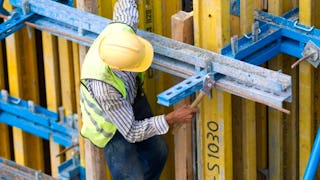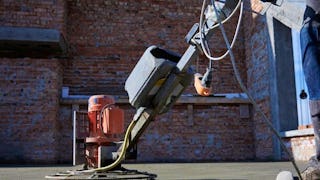Welcome to the course on “Concreting Practices”, a comprehensive course designed to equip learners with the basic knowledge and skills needed in the field of construction.
This course comprises of 5 modules, Module 1 “The blending of aggregates “delves into the fundamental principles in concrete construction involves the careful combination of various types and sizes of materials to achieve a well-graded and homogeneous mixture.. The selection of aggregates, such as crushed stone, gravel, or sand, is based on factors like particle size distribution, shape, and specific engineering requirements. By blending aggregates with different properties, engineers can enhance the workability, strength, and durability of the concrete mix. Achieving the right blend ensures proper compaction and cohesion within the concrete, resulting in a cohesive, well-structured material suitable for diverse construction applications, from foundations to structural elements. The blending of aggregates is a nuanced aspect of concrete mix design, directly influencing the overall quality and functionality of the construction material. In Module 2” Mix design “learners can have a detailed exploration on various process of concrete that involves the various factors to achieve the optimal combination of cement, aggregates, water, and admixtures. The primary objectives of mix design include achieving the required strength, durability, workability, and other specified properties based on the project's structural and environmental requirements. Engineers assess the properties of individual components, such as the gradation of aggregates, characteristics of cement, and the impact of admixtures, to formulate a well-balanced and cost-effective concrete mix. Module 3” Testing on concrete” focuses on learning its quality and performance in construction. Workability tests, such as the slump test, assess how easily concrete can be mixed, transported, and placed without segregation. Compressive strength tests, typically conducted after 28 days, measure the concrete's ability to withstand axial loads, indicating its overall strength and durability. Flexural strength tests evaluate the concrete's capacity to resist bending forces, which is crucial for structural elements like beams and slabs. Together, these tests provide a comprehensive understanding of concrete's properties, ensuring it meets the required standards for various applications. Module 4 “Finishing and curing “involves shaping and smoothing the concrete surface using tools like trowels, achieving desired textures or coatings for specific project needs. Curing, on the other hand, is the process of maintaining proper moisture, temperature, and time for the concrete to reach its intended strength and durability. Both processes demand careful attention and adhere to best practices to ensure the structural integrity, aesthetic appeal, and longevity of the final concrete structure. In Module 5” Issues at Project “the learners will be able to explore construction projects involves addressing specific challenges such as bug holes, concrete placement for high-rise structures, and cold joints. To mitigate bug holes, it is crucial to use well-designed formwork, ensure proper concrete mix proportions, employ effective consolidation techniques, and implement thorough curing processes. For high-rise buildings, coordination of concrete placement, consideration of temperature control, placing the concrete with the help of Boom placers and careful curing are essential to maintain uniformity and prevent issues. Cold joints can be minimized through careful planning, proper surface preparation, and the use of bonding agents. Overall, a robust quality control plan encompassing regular inspections, comprehensive training, and collaboration among stakeholders is vital to ensure construction success. Collectively, the Concreting Practices provides a concise and comprehensive overview of the processes and techniques involved in the preparation, placement, and curing of concrete to ensure high-quality, durable, and structurally sound construction. L&T Edutech offers this unique course to make you understand the basic requirements of concreting practices and ensure that you are ready for the industry!!! Happy Learning!! Target Learners: Post-Graduate Students of Structural Engineering Practicing Engineers in Structural Design Faculties of Civil Engineering Domain Prerequisites: Engineering Mechanics Fundamentals in Strength of Materials & Fluid Mechanics Basics in Concrete Technology Design knowledge of Reinforced Concrete Elements Exposure to relevant codes and standards














